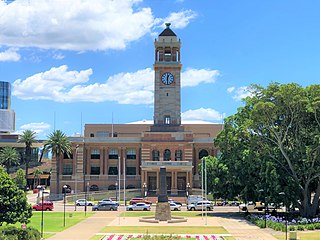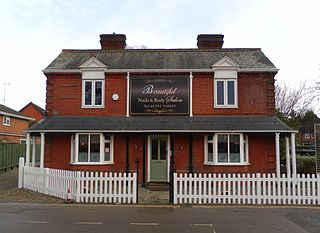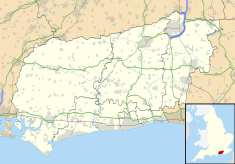
Crawley is a town and borough in West Sussex, England. It is 28 miles (45 km) south of London, 18 miles (29 km) north of Brighton and Hove, and 32 miles (51 km) north-east of the county town of Chichester. Crawley covers an area of 17.36 square miles (44.96 km2) and had a population of 106,597 at the time of the 2011 Census.

Birmingham Central Library was the main public library in Birmingham, England, from 1974 until 2013, replacing a library opened in 1865 and rebuilt in 1882. For a time the largest non-national library in Europe, it closed on 29 June 2013 and was replaced by the Library of Birmingham. The building was demolished in 2016, after 41 years, as part of the redevelopment of Paradise Circus by Argent Group. Designed by architect John Madin in the brutalist style, the library was part of an ambitious development project by Birmingham City Council to create a civic centre on its new Inner Ring Road system; however, for economic reasons significant parts of the master plan were not completed, and quality was reduced on materials as an economic measure. Two previous libraries occupied the adjacent site before Madin's library opened in 1974. The previous library, designed by John Henry Chamberlain, opened in 1883 and featured a tall clerestoried reading room. It was demolished in 1974 after the new library had opened.

Southgate is one of the 14 residential neighbourhoods in Crawley, a town and borough in West Sussex, England. Crawley was planned and laid out as a New Town after the Second World War, based on the principle of self-contained neighbourhoods surrounding a town centre of civic and commercial buildings. Southgate was one of the four in the "inner ring" closest to the town centre, and was intended to be the largest of the nine designed in the original master plan. It was built in two stages between the 1950s and the 1970s, but retains some older buildings from before the New Town era and has "significant areas of pre-New Town character".

Northgate is one of the 14 residential neighbourhoods in Crawley, a town and borough in West Sussex, England. Crawley was planned and laid out as a New Town after the Second World War, based on the principle of self-contained neighbourhoods surrounding a town centre of civic and commercial buildings. Northgate was one of the four in the "inner ring" closest to the town centre, and was the second to be completed: almost all building work on the 168-acre (68 ha) site took place in the first half of the 1950s.

West Sussex County Council is the upper tier local authority for the non-metropolitan county of West Sussex in England.

Tree House, also known as The Tree, is a medieval timber-framed house on the High Street in Crawley, a town and borough in West Sussex, England. It is the original manor house of Crawley, and was built in the early 15th century and rebuilt in the mid-16th century. It now has a modern exterior, but the old structure is still in place inside. Situated in a prominent position facing both the High Street and The Boulevard, two of Crawley town centre's main roads, its name commemorates an ancient elm tree which stood outside for hundreds of years and was one of Crawley's landmarks.

Crawley Hospital is a National Health Service hospital in Crawley, a town and borough in West Sussex, England. Since 2006 it has been part of the Sussex Community NHS Trust, which has overall management responsibility. Surrey and Sussex Healthcare NHS Trust also provides some services. The hospital is located in the West Green neighbourhood of Crawley, near the town centre.

Broadfield House is a 19th-century villa-style house in the Broadfield neighbourhood of Crawley, a town and borough in West Sussex, England. Built in 1830 on the extensive land of the Tilgate Estate south of the small market town of Crawley, it was extended later in the 19th century and converted into a country club. After World War II, Crawley was designated a New Town and had to prepare for rapid, strictly planned growth. Broadfield House was chosen as the headquarters of the Crawley Development Corporation, and became the base where all the decisions that shaped Crawley's future were made. The house, which is still set in parkland, was refurbished and converted for use by Discovery School in 2011. It has been listed at Grade II by English Heritage for its architectural and historical importance.

Crawley Borough Council is the local authority for Crawley in West Sussex, England. The council consists of 36 councillors. It is currently controlled by the Labour Party, led by Michael Jones. The administrative headquarters are at Crawley Town Hall.

The Old Town Hall was a former municipal facility at the corner of King Street and Rodney Street in Wigan, England. The building, which was demolished in September 2013, had been designated a Grade II listed building in 1990.

The Newcastle City Hall is a heritage-listed building located in the regional New South Wales city of Newcastle in the Hunter region in Australia. The building served as the city hall for the Council of the City of Newcastle between 1929 and 1977.

As of November 2010, there were 59 locally listed buildings in Crawley, a town and borough in the county of West Sussex in southeast England. One of these has subsequently been demolished. A locally listed building is defined as "a building, structure or feature that, whilst not statutorily listed by the Secretary of State, the Council considers to be an important part of Crawley's heritage due to its architectural, historic or archaeological significance". Crawley Borough Council administers the selection and deselection process, defines the criteria for inclusion, and produces and updates the local list.

Middlesbrough Town Hall is a municipal facility located in Albert Road in Middlesbrough, North Yorkshire, England. It is a Grade II* listed building.

Crawley, a postwar New Town and borough in the English county of West Sussex, has a wide range of public services funded by national government, West Sussex County Council, Crawley Borough Council and other public-sector bodies. Revenue to fund these services comes principally from Council Tax. Some of Crawley's utilities and infrastructure are provided by outside parties, such as utility companies and West Sussex County Council, rather than by the borough council. To help pay for improved infrastructure and service provision in proposed major residential developments such as Kilnwood Vale and the North East Sector, the borough council has stated that as part of the Crawley Local Plan it would require developers to pay a Community Infrastructure Levy.

Waltham Forest Town Hall is a municipal building located in Walthamstow, East London. The town hall, which is the headquarters of Waltham Forest London Borough Council, is a Grade II Listed Building.

The Old Town Hall is a municipal building in St Paul's Square in Bedford, Bedfordshire, England. The building, which was the headquarters of Bedford Borough Council from 1892 to 2009, is a Grade II listed building.

Worthing Town Hall, or New Town Hall, is a municipal building in Chapel Road, Worthing, West Sussex, England. The town hall, which is a meeting place of Worthing Borough Council, is a Grade II listed building. Located at Chapel Road in the centre of Worthing, it was opened in 1933 and built in a neo-Georgian style to designs by Charles Cowles-Voysey. Containing offices and a Council chamber it replaced Worthing's Old Town Hall as the administrative centre, a building that had been the home of Worthing's local authority from 1835 and was demolished in 1966. To the rear and west lies the Assembly Hall, built in 1935, also to designs by Cowles-Voysey. To the south lies the Worthing Museum and Art Gallery, originally built as a Carnegie Library.

The Municipal Buildings are located on the north side of High East Street in Dorchester, Dorset, England. The structure, which was the headquarters of Dorchester Borough Council, is a Grade II* listed building.




















